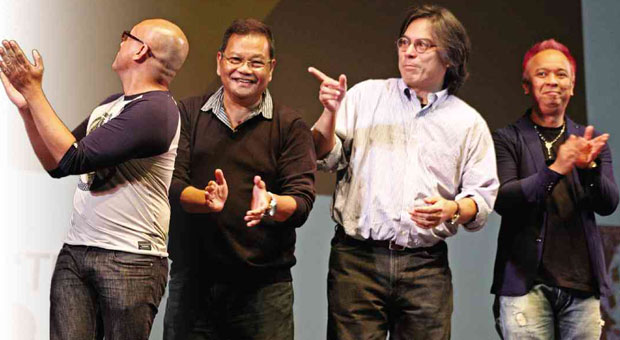State of the indie nation

DIRECTORS’ Showcase (from left): Joselito Altarejos, Joel Lamangan, Carlos Siguion-Reyna and Louie Ignacio (Mike Tuviera is the fifth contender).
For the first time in 10 years, the opening ceremony of the Cinemalaya Philippine Independent Film Festival was moved from the Main Theater lobby into the Main Theater.
Spectators had been crammed into the CCP lobby’s modest space for the previous editions’ opening rites. On Friday, guests were seated comfortably in Tanghalang Nicanor Abelardo and got to watch high-definition trailers of the 25 competing films (10 New Breed, 10 Shorts, 5 Directors’ Showcase) on a big screen. (In the past, trailers were projected on flimsy, gauzy white cloth, which distorted the images.)
The move, it might be said, was indicative of the growth of the annual fest’s audience.
As Nes Jardin, president of the Cinemalaya Foundation, pointed out in his welcome address: “From 8,000 people in the inaugural edition … 82,000 watched Cinemalaya films last year.” He said that organizers hoped to attract 90,000 to 100,000 to its main venue (the Cultural Center of the Philippines) and its four satellite locations (Greenbelt, TriNoma, Alabang Town Center and Fairview Terraces) throughout the current festival, which ends Aug. 10.
Jardin had good news: “Over 50 percent of the CCP screenings were sold out [on opening day].”
Article continues after this advertisementGoing global
Article continues after this advertisementCinemalaya has grown in other ways, as well.
It has gone “international,” for one, with its choice for opening film, Filipino-American journalist Jose Antonio Vargas’ documentary on immigration reform, “Documented.” Vargas’s mother Emelie Salinas, half-siblings Czarina and Carl and several other relatives attended the screening. Salinas received a certificate of recognition for her son, a successful journalist, but undocumented immigrant, in the United States.

NEW BREED filmmakers (from left): Janice O’Hara, GB Sampedro, Nick Olanka, Milo Sogueco, Ida Anita del Mundo, Giancarlo Abrahan, Derick Cabrido, Francis Xavier Pasion, Real S. Florido and Gino M. Santos.
“It was overwhelming to hear and see people’s reactions,” said Salinas’ daughter. “I first watched it online,” Salinas said. “This was my first time to see it on the big screen, with an audience.”
The closing film, “A Thief, A Kid & A Killer,” is directed by Korean-American filmmaker Nathan Adolfson and top-billed by Filipino actors Epy Quizon, Lance Raymundo and Felix Roco.
The Hollywood Foreign Press Association (HFPA, which hands out the annual Golden Globes) presented an award to Cinemalaya organizers—led by foundation chair Antonio “Tonyboy” Cojuangco and competition chair Laurice Guillen.
Globes race
- CINEMALAYA chair Tonyboy Cojuangco attended Friday’s rites with partner Gretchen Barretto.
Represented by former chair (and Inquirer columnist) Ruben V. Nepales and his wife Janet, the HFPA lauded the fest’s contributions to Philippine indie cinema.
In its first 10 years, Cinemalaya has produced five films that represented the country in the Best Foreign Language derby of the Oscars: Kanakan Balintagos’ “Ang Pagdadalaga ni Maximo Oliveros” (2006), Adolfo Alix Jr.’s “Donsol” (2007), Marlon Rivera’s “Ang Babae sa Septic Tank” (2011), Jun Robles Lana’s “Bwakaw” (2012) and Hannah Espia’s “Transit” (2013).
Nepales noted that “Transit,” Best Film winner in the New Breed section last year, made it to the Golden Globe’s Best Foreign Language race as well.
“I wouldn’t be surprised if the first Filipino film to be nominated for Best Foreign Language Film would be produced by Cinemalaya,” Nepales said.
Creative community
Hope seemed to be the opening night’s theme. It is easy to get jaded, even pessimistic over time, but Cinemalaya organizers have remained doggedly, defiantly
optimistic in spite of numerous challenges—on top of the list being marketing and distribution.
In his speech, Chris Millado, Cinemalaya festival director, hailed the entire community: The filmmakers for “fearless storytelling’; the “daring producers” for “mobilizing resources”; the actors (“fledgling, emerging, established and mainstream”) for “fleshing out unforgettable characters,” and the “committed creative and production staffers” who embark on this “insane and passionate project of indie filmmaking.”
Millado thanked the media (for being “the first ones to ring the bells loudly when we had successes here and abroad”) and the audiences (“who filled the theaters, applauded, then tweeted and posted [appreciative notes online]”). He said this growing, vibrant and hopeful community is “the force behind Cinemalaya.”
He declared: “We celebrate hope … that springs from the collective creativity … the same creative energy that makes me believe that it will be the artist, not the politician or lawmaker, that will ultimately save this country from mediocrity and despair though his/her enduring vision.”
And that’s the state of this “indie” nation.
Email [email protected].
PHOTOS BY KIMBERLY DE LA CRUZ



